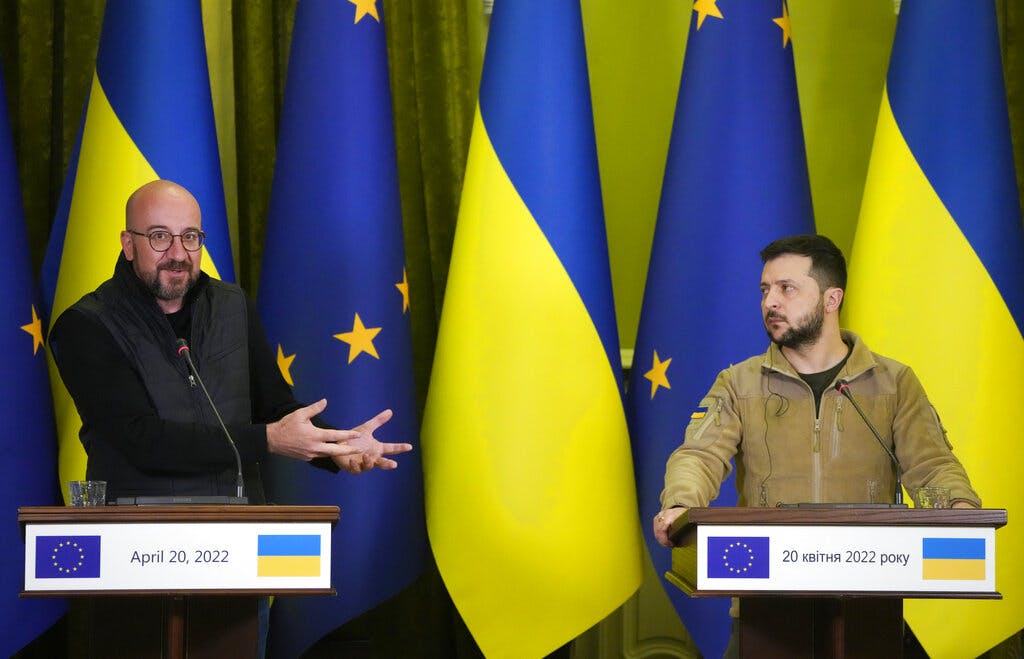The War in Ukraine, Seen on Digital Atlases and Via Electronic Briefing
Journalists, distant observers, and armchair tacticians these days turn not to in-person briefings but rather to their smartphones, and they see Ukrainian battlefields themselves in close to real-time.

KYIV, Ukraine — During the Vietnam War, American military spokesmen briefed members of the press daily with news of the battlefield from the Rex Hotel in Saigon. The meetings were known informally as the Five O’Clock Follies.
In a 1982 oral history, Barry Zorthian, best known for his role overseeing the daily meetings, complained that during the briefings, “the government’s word was to be questioned until proven true, whereas in the past it had been the government’s word is valid until proven to be wrong.”
Journalists derided the meetings. The Associated Press’s Saigon bureau chief, Richard Pyle, infamously questioned their credibility, calling them “the longest-playing tragicomedy in Southeast Asia’s theater of the absurd.”
Fast-forward to 2022, and journalists, distant observers, and armchair tacticians turn not to in-person briefings but rather to their smartphones, and they see Ukrainian battlefields themselves in close to real-time.
The messaging application Telegram is a one-stop shop for conflict information and is particularly popular in Ukraine. Private individuals, local media, politicians, and even the defense ministry curate Telegram channels and post videos, pictures, and commentaries.
The Azov Battalion, a group of fighters that serves under the auspices of the Ukrainian National Guard, maintains a robust but raw and unfiltered Telegram presence.
The Battalion’s legacy is complex. They’ve had far-right ties in the past — and have been connected to several war crimes — though the group has made an effort to purge its ranks of the ideologically extreme.
One of its well-known Telegram channels — with more than 390,000 subscribers as of this writing — covers the group’s operations in its hometown, Mariupol, the besieged Ukrainian port city in the southeast of Ukraine.
Despite Russian pronouncements of Mariupol’s imminent fall, the group this week posted a video of an Azov fighter peering from behind cover and hitting a Russian armored vehicle with a German-supplied anti-armor missile system.
Although that clip is relatively bloodless, some videos posted to the channel are more intense and decidedly more gruesome. The group has also recently posted drone footage of an Azov assault on several Russian positions in the city.
In the minute-and-a-half-long video, Russian troops face the business end of Azov’s rifles, and grenades tossed over a brick wall by Azov fighters explode among a group of Russian soldiers.
Telegram channels covering this conflict are myriad, and journalists can access content from hundreds of thousands of Russian, Ukrainian, and English channels.
Telegram helps stay up-to-date on what is happening in Ukraine, a staff writer at the Kyiv Independent, Ukraine’s most prominent English-language newspaper, Asami Terajima, said.
“There are many news channels on Telegram where I can get instant news updates,” Ms. Terajima explained, adding that the origin of information passed through Telegram can sometimes be opaque.
It is also important to note that “in Ukraine there are many Telegram channels that belong to local authorities or to government officials” that journalists use to keep up to date on the events throughout the country.
Telegram can sometimes be the “quickest way” for officials to get reliable information out to the public quickly, particularly important for a country at war.
If Telegram offers users a gritty, first-person view of events on the ground, several other resources provide a markedly sterile and facts-based, birds-eye view of the conflict.
In some cases, Russia’s invasion force relied on 20-year-old paper road atlases to guide their war machine through the Ukrainian countryside and toward Kyiv, the Ukrainian capital.
However, journalists and pundits following this conflict from Ukraine and elsewhere rely not on paper maps marked with pen and pencil but digital maps.
LiveUAMap — short for Live Universal Awareness Map — collates information posted online about the Russian invasion, updating a digital map of Ukraine and reflecting the situation on the ground.
A pair of Ukrainian software engineers developed LiveUAMap in the wake of Russia’s initial invasion of Ukraine in 2014. Although the application has since expanded to cover other conflicts, Russia’s renewed offensive made the app freshly relevant in Ukraine.
Missile strikes and bombings hit Ukrainian cities every day. Sadly, gun battles and civilian deaths are a common occurrence — and staying on top of the day’s events would be a challenge even for a team of dedicated analysts.
Instead, LiveUAMap’s software trawls the internet looking for information related to events on the ground. When it comes across relevant — and credible — data, the application adjusts its map to reflect changes on the battlefield.
Colored indicators show where and what kinds of attacks have happened and which Ukrainian regions are under aerial threat. Shaded areas indicate the farthest extent of Russia’s advance into Ukraine. Events are clearly sourced and vetted by fact-checkers for accuracy.
Another map published and updated by the Twitter account Ukraine War Mapper has proven a valuable resource for visualizing this conflict. The map relies on Soar.Earth, an online mapping platform that allows users to create their own digital atlases.
The highly detailed map uses satellite imagery to reflect changes on the Ukrainian battlefield, complete with observed Russian troop movements as well as areas recaptured by Ukrainian forces and forward Russian operating areas.
Despite the plethora of access points to digital information, there are more traditional avenues for information dissemination in this conflict.
The Ukraine Crisis Media Center, a Ukrainian non-governmental organization, holds daily briefings at press offices in Kyiv and Lviv to dispel the informational fog of war and maintain an official and in-person line of communication between government officials and journalists.
The venues allow Ukrainian government representatives to summarize and comment on the events of the day and field questions from reporters covering this conflict.
During a press briefing this week, Colonel Oleksandr Motuzyanyk, a Ukrainian ministry of defense spokesman, announced that the next phase of this war, the Battle of Donbas, had begun, as evidenced by the “intensification of Russian action on the front line.”
He added that Russian forces had taken a page out of Soviet-era military doctrinal textbooks, emphasizing heavy, massed artillery fire, and commented on Russia’s intentions at this stage in the conflict.
The intense Russian artillery barrage was an “attempt to keep Ukrainian units in place,” Mr. Motuzyanyk said. Russia’s objective is to “surround Ukrainian forces to take towns and villages” and destroy them.
Although no Five O’Clock Follies, the daily briefings thread the needle between informing the press on the current situation and putting the kibosh on questions that could inadvertently disclose sensitive military information.
Despite the reliance on digital technology and the rapidity with which information can be spread electronically, in Ukraine in 2022, there is no substitute for hearing news straight from the source.

